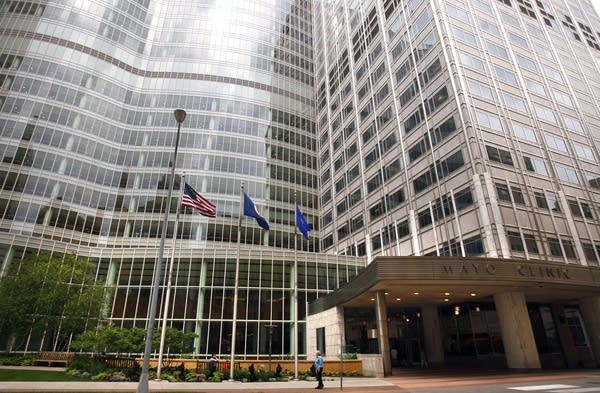Mayo, a financial powerhouse, is poised to propel expansion
Go Deeper.
Create an account or log in to save stories.
Like this?
Thanks for liking this story! We have added it to a list of your favorite stories.

Mayo Clinic wants to invest billions of dollars of its own money in a project aimed at bolstering the medical center's position as a world destination for health care. The clinic is now trying to line up state subsidies and private investors to round out financing for what would be a grand expansion. But does Mayo itself have the money needed to pull off such a huge project?
On Mayo's Rochester campus, with three times the square footage of the Mall of America, a small portion of the space is devoted to a hall of benefactors. Plaques honor individuals, businesses and institutions that have supported Mayo financially. And they do give generously: From 2009 to 2011, Mayo received about $900 million in gifts and pledges.
The clinic's success in attracting such donations is one reason Mayo looks like a very good bet to make good on its promise to kick in $3.5 billion over 20 years to fund its latest expansion.
Turn Up Your Support
MPR News helps you turn down the noise and build shared understanding. Turn up your support for this public resource and keep trusted journalism accessible to all.
MORE COVERAGE
• Mayo, Vikings stadium aid requests compared
• Expansion may create jobs, but how many?
• Mayo chief wants 'destination medical center'
• Document: Mayo Clinic's expansion plan
"I don't think it's any stretch at all, within our current financial strength," said Pat McCarty, Mayo's vice chair of financial planning and analysis.
In addition to deep-pocketed benefactors, McCarty noted that Mayo also has billions of dollars in investments it can tap, strong income from clinic operations and access to lenders eager to provide the clinic with a lot of money at low interest rates.
"Lenders see us very favorably," McCarty said. "Our debt load is well within our means."

Mayo has an AA credit rating. Higher ratings are very rare. Harvard has an AAA rating, as does Microsoft. But with an AA rating, bonds issued by Mayo are deemed as safe as those issued by the federal government.
Still, the health sector poses plenty of challenges.
There's the impact of the new federal health care law, possible cuts in Medicare funding, a shortage of nurses and much more. Mayo has laid out these and other risks in some recent financial documentation.
• Chart: Mayo's operating income
Every health care provider faces similar challenges, said Steve Parente, director of the Medical Industry Leadership Institute at the University of Minnesota, but few are as well-positioned as Mayo to deal with them.
"They are more well endowed than probably most any health care organization in the country."
"To the extent that Mayo can document that it's producing very high quality results, patients will gravitate toward it, if they have the resources," he said. "And more likely than not the public insurance programs will continue to support it."
Parente said he thought Mayo's big project is well within the clinic's means.
"I think it's viable," he said. "It's probably more than viable."
But there are internal financial challenges as well. Some of Mayo's assets cannot be turned into cash quickly, and there are restrictions on how some money can be used.
Mayo also has huge obligations to the pension plan for its employees. Mayo has pumped hundreds of millions of dollars into the plan in recent years, and there could be more big cash infusions down the road.
Last week, Standard & Poor's cited the pension obligations as one factor when the credit rating agency announced it could cut Mayo's rating slightly. Without some improvement in cash flow or curtailment of capital spending, a one-notch downgrade to AA- could occur within the next two years, the agency said in a report on Mayo.
S&P affirmed Mayo's current rating but cited the clinic's weaker-than-expected financial performance in the second half of last year and $300 million in debt Mayo recently issued to S&Ps surprise.

For now, Mayo retains its AA rating, which indicates very strong capacity to meet financial commitments.
Later this week, Mayo will disclose its financial performance for last year.
Mayo is strong, despite its challenges, said Elizabeth Keating, a Boston University expert in assessing the financial performance of nonprofits.
"From a profitability standpoint they are successful," she said.
Over the past three years, Mayo has had total income of more than $1 billion, including gifts. And Keating said Mayo, like Harvard, can count on benefactors to make large donations for building projects.
"I don't doubt people will step forward and write large checks," she said. "In a 20-year period, they should be able to successfully put together a package of financing and donations that'll allow them to do this."
Number-crunchers say Mayo is at the top of its league, not just when it comes to health care but also finances.
"They are more well endowed than probably most any health care organization in the country," said Joe Grasso, who teaches nonprofit finance at Cornell University. "They truly are in a rarified category of high quality, healthy health-care centers."
Grasso said that organizations like Mayo must make bold moves and take prudent risks if they are to continue as leaders in their field and fuel regional and state economic growth.
The question for the state of Minnesota is what economic benefits this project will yield and whether they will warrant about a half-billion dollars in government subsidies.



